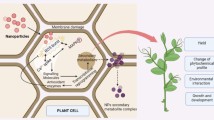Abstract
Campothecin production was increased with elicitors, methyl jasmonate, jasmonic acid, yeast extract elicitor, and ferulic acid in suspension cultures ofCamptotheca acuminata. jasmonic acid was found to be the most efficient elicitor. Camptothecin production increased 11 times by using the optimum dosing concentration of jasmonic acid which was 50 μM. The kinetics of camptothecin accumulation in response to the treatment with jasmonic acid showed that the camptothecin accumulation reached the maximum value at 4 days after jasmonic acid dosing and then a rapid decrease in camptothecin accumulation was observed.
Similar content being viewed by others
References
Wall, M. E., M. C. Wani, C. E. Cook, K. H. Palmer, A. T. McPhail, and G. A. Sim (1966) Plant antitumor agents. I. The isolation and structure of camptothecin, a novel alkaloidal leukemia and tumor inhibitor fromCamptotheca acuminata.J. Amer. Chem. Soc. 88:3888–1890.
Hsiang, Y-H. and L. F. Liu (1988) Identification of mammalian DNA topoisomerase I as an intracellular target of the anticancer drug camptothecin.Cancer Res. 48:1722–1726.
Hsiang, Y-H, L. F. Liu, M. E. Wall, M. C. Wani, A. W. Nicholas, G. Manikumar, S. Kirschenbaum, S. Silver, and M. Potmesil (1989) DNA topoisomerase I-mediated DNA clevage and cytotoxicity of camptothecin analogue.Cancer Res. 49:4385–4398.
Jaxel, C., K. W. Kohn, M. C. Wani, M. E. Wall, and Y. Pommier (1989) Structure-activity study of the actions of camptothecin derivatives on mammalian topoisomerase I: evidence for a specific receptor site and a relation to tumor activity.Cancer Res. 49:1465–1469.
Zihou, M., H. Malak, and T. G. Burke (1995) Reduced albumin binding promotes the stability and activity of topotecan in human blood.Biochemistry(ACS) 34:13722–13728.
Suzuki, A. and M. Kato (1996) Chemotherapeutic agent CPT-11 induces the new expression of the apoptosis initiator to the cytoplasm.Exp. Cell Res. 227:154–159.
McNeil, C. (1996) Topotecan: After FDA and ASCO, what’s next?J. Nat. Cancer Inst. 88(12): 788–789.
Wall, M. E. and M. C. Wani (1995) Camptothecin and Taxol: Discovery to clinic-thirteenth Bruce F. Cain in Memorial Award Lecture,Cancer Res. 55:753–760.
Byun, S. Y., Y. W. Ryu, C. Kim, and H. Pedersen (1992) Elicitation of sanguinarine production in two-phase cultures ofEschscholtzia california.J. Ferment. Bioeng. 73:380–385
Sakato, K., H. Tanaka, N. Mukui, and M. Misawa (1974) Isolation and identification of camptothecin from cells ofCamptotheca acuminata suspension cultures.Agr. Biol. Chem. 38:217–218.
Sakato, K. and M. Misawa (1974) Effects of chemical and physical conditions on growth ofCamptotheca acuminata cell cultures.Agr. Biol. Chem. 38:491–497.
Hengel, A. J., M. P. Harkes, H. J. Wichers, P. G. M. Hesselink, and R. M. Buitelaar (1992) Characterization of callus and camptothecin production by cell lines ofCamptotheca acuminata.Plant Cell, Tissue and Organ Cult. 28: 11–18.
Grisebach, H. (1986) Phytoalexin accumulation, p. 355. In: H. Kleinkauf (ed.), Regulation of secondary metabolite formation. Worksh Conf, Hoechst 16, VCH Publishers Inc., Weinheim.
Etlinger, C. and L. Lehle (1988) Auxin induces rapid changes in phosphatidyl-inositol metabolites.Natur 331(6152):176.
Mikukami, H., Y. Tabira, and B. E. Ellis (1993) Methyl jasmonate-induced rosmarinic acid biosynthesis inLithospermum erythrorhizon cell suspension cultures.Plant Cell Rep. 12: 706–709.
Staswick, P. E. (1992) Jasmonate, genes, and fragrant signals.Plant Physiology 99:804–807.
Weiler, E. W., T. Albrecht, B. Groth, Z-Q Zia, M. Luxem, H. Liss, L. Andert, and P. Spengler (1993) Evidence for the involvement of jasmonates and their octadecanoid precursors in the tendril coiling response ofBryonia dioica.Phytochemistry 32:591–600.
Gundlach, H., M. Muller, T. Kutchan, and M. Zenk (1992) Jasmonic acid is a signal transducer in elicitor-induced plant cell cultures.Proc. Natl. Acad. Sci. U.S.A. 89:2389–2393.
Kauss, H., K. Krause, and W. Jeblick (1992) Methyl jasmonate conditions parsley suspension cells for increased elicitation of phenylpropanoid defense responses.Biochem. Biophys. Res. Commun. 189:304–308.
Ju, Y.W., and S.Y. Byun (1994) Precursor feeding experiments with elicitation in suspension cultures ofEschscholtzia californica.Plant Tissue Culture Letters 11:112–115.
Author information
Authors and Affiliations
Corresponding author
Rights and permissions
About this article
Cite this article
Song, S.H., Byun, S.Y. Elicitation of camptothecin production in cell cultures ofCamptotheca acuminata . Biotechnol. Bioprocess Eng. 3, 91–95 (1998). https://doi.org/10.1007/BF02932509
Issue Date:
DOI: https://doi.org/10.1007/BF02932509




